Project Overview
Information Products
Commodities
- Agronomic: hops
Practices
- Crop Production: food product quality/safety, postharvest treatment
- Production Systems: general crop production
Summary:
We built a mobile hop dryer that will quickly dry hops to national quality standards for processing, storage and sale, while allowing sharing among collaborating growers, reducing the need for all growers to build fixed facilities, saving them money, and improving crop quality and marketability. Our problem was to find a way to quickly dry hops to the ideal moisture content for processing, while reducing individual farmer investment by creating a shareable resource. Drying hops is time sensitive from start to finish. The sooner that harvested hops can begin and finish the process, the higher the quality, and more marketable. Hops (like any vegetative product) begin to break down as soon as they are picked, potentially resulting in off flavors that reduce their marketability. Conversely, immediate entry into the drying process and rapid completion prevents damage, and maximizes oil and acid retention that give hops the flavors and aromas desired, improved pelletability and storage, and thus sales potential and price point. Many growers rely on other farmer’s drying facilities, increasing travel and time between harvest and drying. Farmers who have immediate access can produce a much higher quality hop than those who don’t. Several growers in Ohio also process hops into pellets, the form required by brewers. These processors report most hops they receive are not dry enough, requiring them to be re-dried, further degrading their quality. We know of one commercially available small-scale dryer; a fan unit with blueprints for the dryer that costs $3800, materials not included. Several growers have built fixed drying facilities which allow on-farm drying which have proven to be effective and efficient. However, they cost several thousand dollars and permanently take up floor space. Practically and financially, not every farm needs to tie up space and money in a dryer. Sharing is viable, since drying takes ~48 hours, and Ohio’s harvest starts in the southwest in July and continues through September in the northeast with about a seven to ten day harvest window per variety. It is practical that numerous growers could use one mobile dryer.
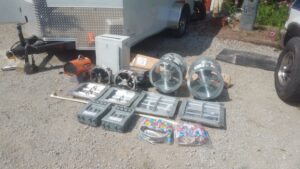
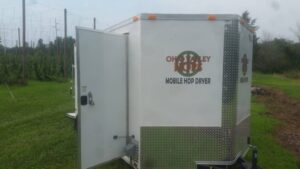
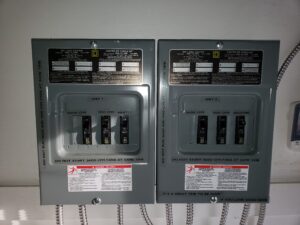
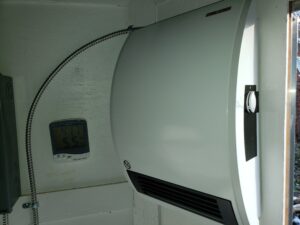

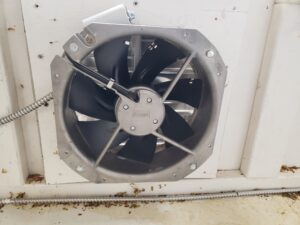
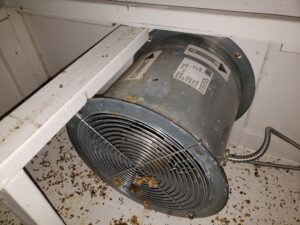
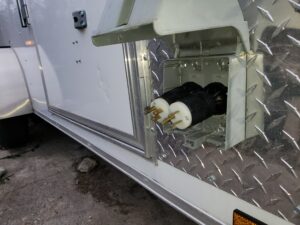

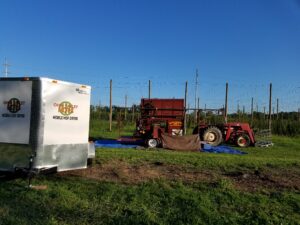
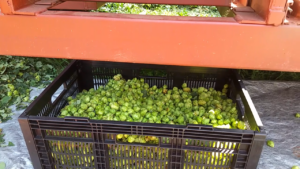
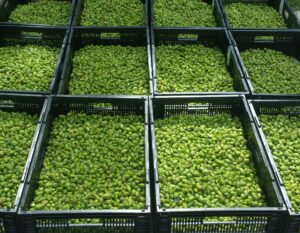
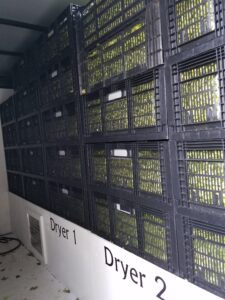
Project objectives:
We proposed to build a prototype mobile hop dryer that incorporates best drying practices from small-scale hop growers. It would facilitate immediate drying after picking. It will be shared among a group of growers who manage their harvest dates to maximize utilization, eliminate the cost and inefficiency of a fixed facility, while improving the quality and marketability of their crop. The design could be replicated and shared collaboratively by other groups of growers.
It was built in an enclosed trailer, with a two-step, 48 hour drying process involving high volume air movement for initial drying and then lower volume conditioned air for finishing, powered by a generator for complete mobility, with food safe materials and practices as required. Although using proven drying techniques, we tested to ensure this design is able to accomplish its intended goal of drying the crop to accepted moisture content standards within approximately 48 hours. It performed well- with a complete load of over 1000 pounds of hops, the hops were dried and conditioned in less than 48 hours. Smaller loads took as little as 24 hours.
We cooperatively shared the dryer with 4 Ohio based farmers the first year to test scheduling and sharing, and shared with 5 second years, determining that the optimal number of farms that can be served by a mobile hop dryer is even more than that.
We proposed to use a number of factors to determine success.
Crop quality. We will gather and compare data between hops dried in the mobile dryer and those dried by other means. We will gather data from farmers who we dry for, comparing 2016 crop testing data with 2017 data where we can; and with larger farms who are willing (including our farm), have them split their crop with their existing process and the mobile dryer. Items we will pay particular attention to will include total drying time, and lab test results that include the Hop Storage Index (HSI) -- which indicates how long the hops can be stored and is a direct measure of the quality of the drying process -- as well as alpha acid and beta acid content, which are critical to the science and art of brewing, and are greatly impacted by the quality of the drying process. We will tabulate data from each farm on spreadsheets for analysis.
Grower perception. We will construct a survey that gathers grower perceptions about ease of scheduling, ease of use, quality of process, quality of product, brewer satisfaction with product, and likelihood of future use. We will also follow up after they sell their hops regarding feedback from their brewer customers about quality.
Processor perception. We will construct a survey of processors about the quality of raw product they receive, and its readiness for pulverizing and pelletizing, comparing those who dried using the mobile hop dryer and those who did not.
We will repeat this process in year two, also looking for increased demand for the mobile hop dryer and comparing the data to year one. A key measure of success in year two would be another farmer or group of farmers replicating the mobile dryer.
Our research conclusions are hindered by the fact that we were the only farm that used the dryer two consecutive years. Two of our cooperators in year one liked the system so much that they built their own fixed dryers, and so did not require usage. Another grower stopped growing hops due some life changes, and the fourth had a terrible growing year and didn't have enough hops to justify harvest. That said, we had five new farmers use it the second year.
Crop Quality. Both years, our users reported their hops dried well within the projected time and were ready for processing with no further drying required. The second year, we changed our heating system to a thermostatically controlled electric heater set to 105-100 degrees, and it further reduced drying time. Using our own lab testing results, we found that our labs were steady both years, and well within the industry standards for hop storage index (HSI), and alpha and beta acids for each variety dried. We had a slight improvement in HSI in year two, but that may or may not be attributable to faster drying times.
Grower perception. Both years, growers who used the dryer were satisfied with the ease of use, portability, and effectiveness. The first year we provided written instructions through email, but found that not all users read them that year, so the second year we put them on a foam core poster and mounted them inside the trailer so they were easily accessible, and all users were able to have them at hand through the whole process. Transport was easy- growers simply picked up the trailer, pulled it to their site, used it and returned it or it was picked up by the next user. A few phone calls or text messages was all that was necessary to facilitate moving it along.
Processor perception. Two Ohio processors pelletized hops dried in the mobile dryer. From many discussions over the last several years, processors biggest gripe is that growers do not dry their hops evenly or thoroughly. That was not the case with the mobile dryer. Simply following provided instructions on bin rotation, use of heat and air, and moisture testing led all users to get their hops in the 8-10% moisture range, ideal for further processing and packaging.
Adoption by other growers. I have provided plans, materials lists and talked with five hop growers (from FL, CT, OH, KY and NY) who have indicated they are going to build a similar system, but at this time don't know if they followed through. I have had further interest from growers at showings.